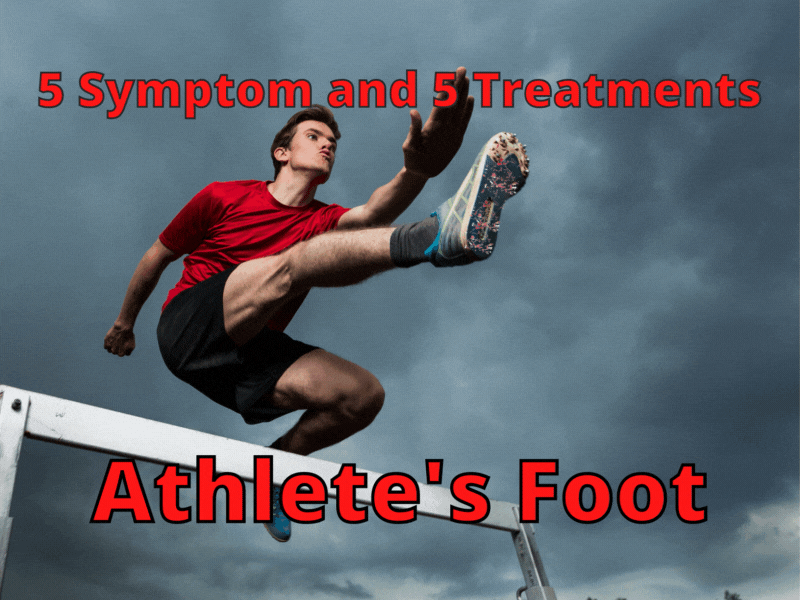(This Article is not meant as medical advice) If your feet feel itchy and you’re not sure why, it could mean several things, but it may also be caused by a fungus also called athlete’s foot. It is common in public places where people go barefoot, like the gym locker room.
Athlete’s foot can cause red itchy flaky skin. It can usually be self-diagnosed (or by a doctor). You can buy over-the-counter medicine to treat it but sometimes more powerful medicine is needed.
If you have athlete’s foot you can get help to treat it and prevent it from coming back. If you’re consistent and careful you can treat the irritation and problems caused by this fungus. After a few weeks, you may be able to be free of this issue.
What is Athlete’s Foot?
Dermatophytes are a type of fungus that causes athlete’s foot. They can “cause superficial infections of the skin, hair, and nails.” (aafp.org) When your feet come in contact with this fungus, it can infect your foot.
Walking barefoot at the pool, gym, or public places where others go barefoot can expose you to this fungus. Depending on several factors determine if you will get infected with athlete’s foot.
One factor is your foot’s environment. Areas where moisture may be trapped, like between your toes, are more likely to see athlete’s foot. You will likely see “a scaly rash that usually causes itching, stinging and burning.” (mayoclinic.org)
Determining If You Have Athlete’s Foot
If you feel irritation around your toes you may want to want to keep watch and see if there are any signs of athlete’s foot.
Here the five signs to look out for:
- Redness of skin like a rash – One area of skin is a different color.
- Very itchy skin – It may feel an itch that is difficult to relieve.
- Flaky skin – Dry skin that flakes off.
- Peeling/cracking broken skin – The skin starts to peel and open or crack.
- Scaling on your soles – Looks like peeling dry skin on your soles.
1. Red Skin
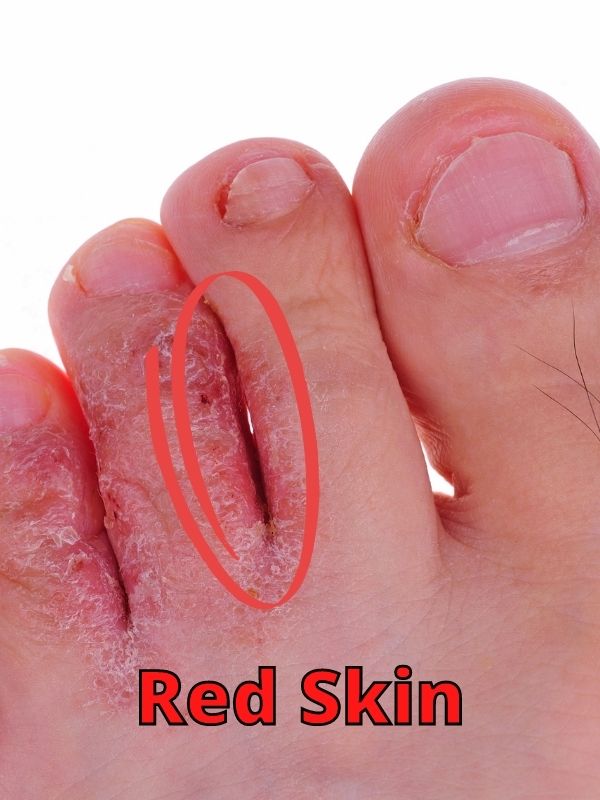
When you start to notice that your skin color looks different even after you’re out of the shower for a while, then you may have athlete’s foot.
Like a rash on your foot, athlete’s foot can cause your skin color to change because it is infected with fungus.
2. Itchy Skin
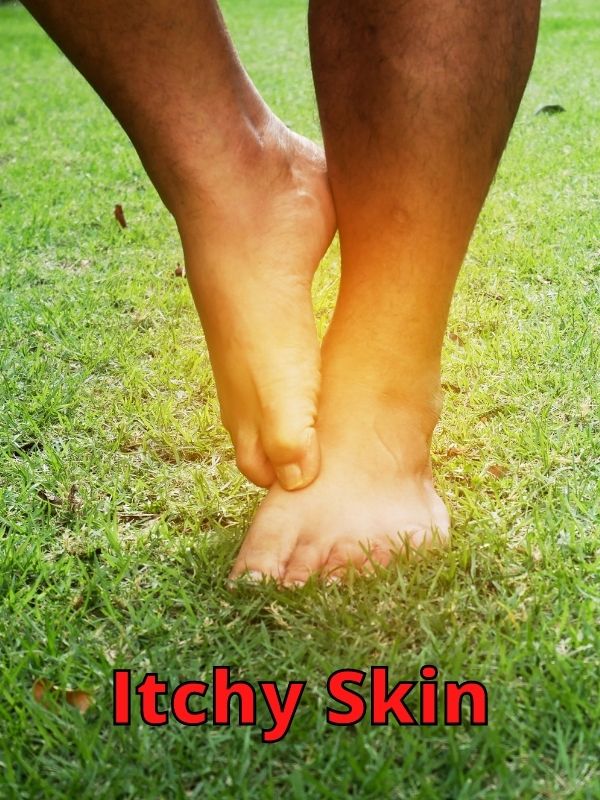
If you find yourself rubbing your toes together or itching between your toes with your feet or your hands, you may have athlete’s foot.
Sometimes your feet itch from time to time, so you may not notice anything wrong with your feet at first. They may feel just a bit itchier.
Once the itching starts to get intense and you look closer you may notice something looks different about your feet. You may have athlete’s foot.
3. Flaky Skin
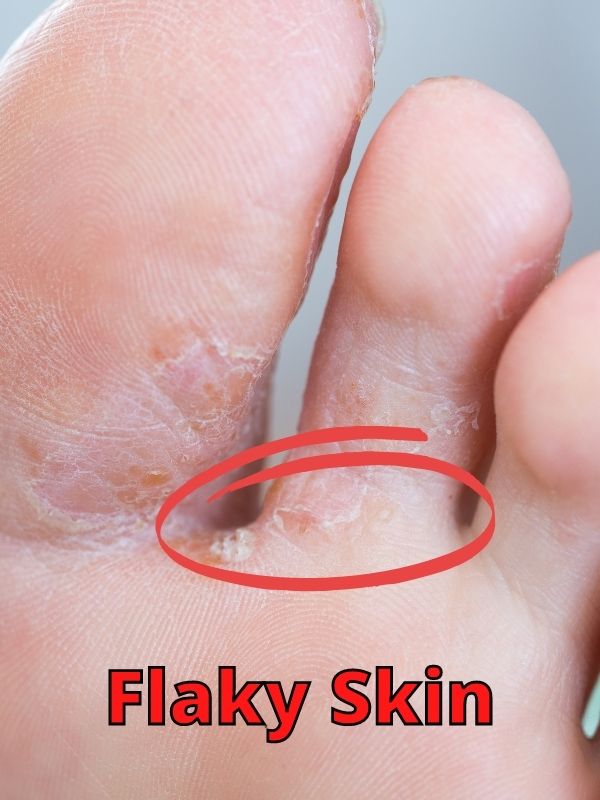
Sometimes our skin will get dry and flake or too moist and start to peel. This is normal but if you notice it spreading or looking different than usual, this could be athlete’s foot.
Dry skin usually affects the heel more than anything if you wear shoes regularly. So if flaking occurs around your toes you should check closer to see if it’s athlete’s foot.
4. Peeling/Cracking Skin

If you go on a hike or do something that rubs your skin more than normal, your skin might start to peel afterward. My skin sometimes peels on the top of my feet from too much sun at the beach.
Sometimes cracking around the heel is caused by dry skin, especially with older individuals. This can be prevented in some cases by drinking plenty of water.
If you notice peeling and cracking around the toes and you haven’t been doing anything different, this could be athlete’s foot.
5. Scaling on Soles

If the bottom of your foot starts to get patches of skin that start to flake and peel off then you may have athlete’s foot.
Although, for seniors, dry skin may be a common foot condition. It may not lead to large sections of peeling flaky skin.
For athlete’s foot, sometimes it’s just one section of the sole that is scaly but it could be a large area of the sole as well.
5 Ways to Treat Athlete’s Foot
Normal over-the-counter medicine can cure athlete’s foot for most people. This can take 2 or more weeks. Sometimes you may need to take the medicine longer or go to the doctor and get stronger medicine.
Keeping your feet clean by washing each day and keep your feet dry as much as possible. You can wear sandals without socks when going out to help keep your feet dry. Wear well-ventilated shoes and socks if you need to wear shoes.
Here are 5 ways to treat athlete’s foot:
1. Over the Counter Medicine
You can get many products that are supposed to help with athlete’s foot. These medications come with medication in the form of a cream, a spray, or a powder. They contain anti-fungal agents like Butenafine Hydrochloride, Miconazole Nitrate, and Tolnaftate.
If you’re looking for something more homeopathic with natural ingredients, there are several you can use to treat your feet, but be careful to choose ones that are specifically for athletes’ feet.
Some products are for foot odor and not athlete’s foot, although they may help you stop the reoccurrence of athlete’s foot. Check out the user reviews to get an idea of how it worked for them.
Tea Tree Oil Balm

Ingredient:
Macadamia Nut Oil, Safflower Oil, Olive Oil, Cetostearyl Alcohol, Tea Tree Oil, Eucalyptus Australiana Oil, Beeswax, Tocopherol Acetate (Vitamin E), Lavender Oil, Rose Geranium oil, Vitamin C
Tree Foot Soak

Ingredient:
Dead Sea Salt, Epsom Salt, MSM, Tea Tree, Rosemary, Peppermint, Spearmint, Cajeput, Eucalyptus
2. Going to the Doctor
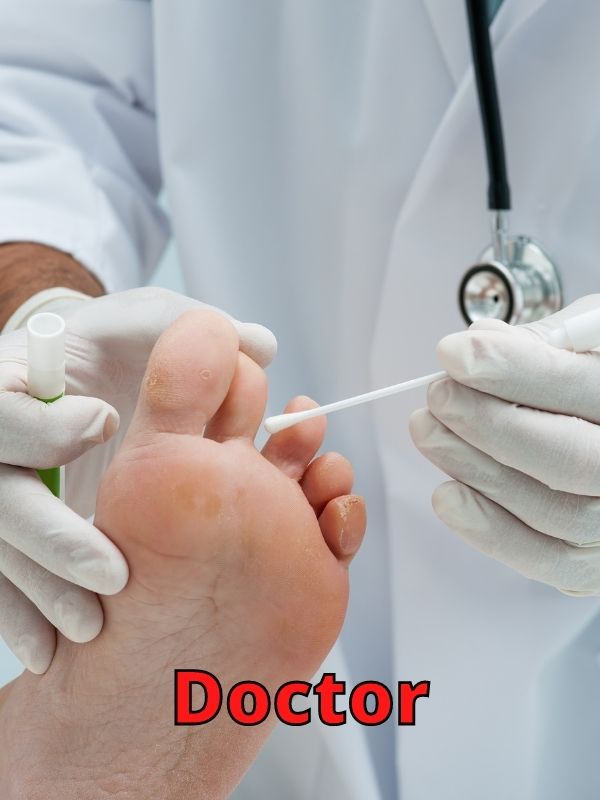
The doctor can evaluate your athlete’s foot. They can find out what exactly the problem is, and they have a variety of medicines you can try. Many people go to the doctor when their athlete’s foot doesn’t respond to treatment.
If you have diabetes or a weak immune system, you should go to the doctor to get advice about medicines and the side effects they may have.
Sometimes your athlete’s foot may come back or never really go away. A doctor can help you manage and plan a strategy for reducing and getting rid of the infection.
3. Listerine Foot Bath
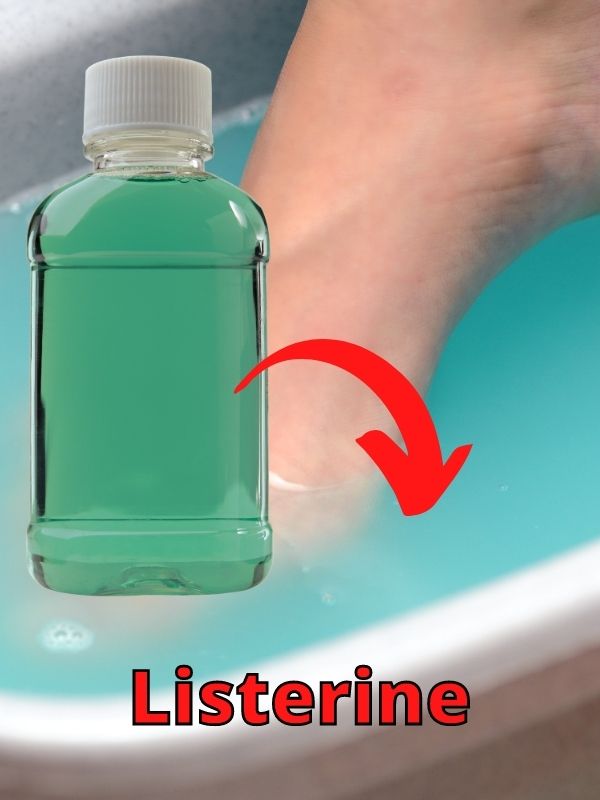
Although this treatment is not a medication, it may work for some people. Listerine has “antifungal properties found in menthol and thymol” (Healthline.com)
Using this method can help reduce your athlete’s foot and may even cure it. If you are willing to do it every day for about 45 minutes, it may help.
All you need to do is fill a “tub with Listerine along with two parts of warm water.” (Healthline.com) Just be cautious before using a little Listerine on your skin and wait to see if you have any sort of reaction. If your skin is too sensitive, you should opt for something else.
4. Sunlight
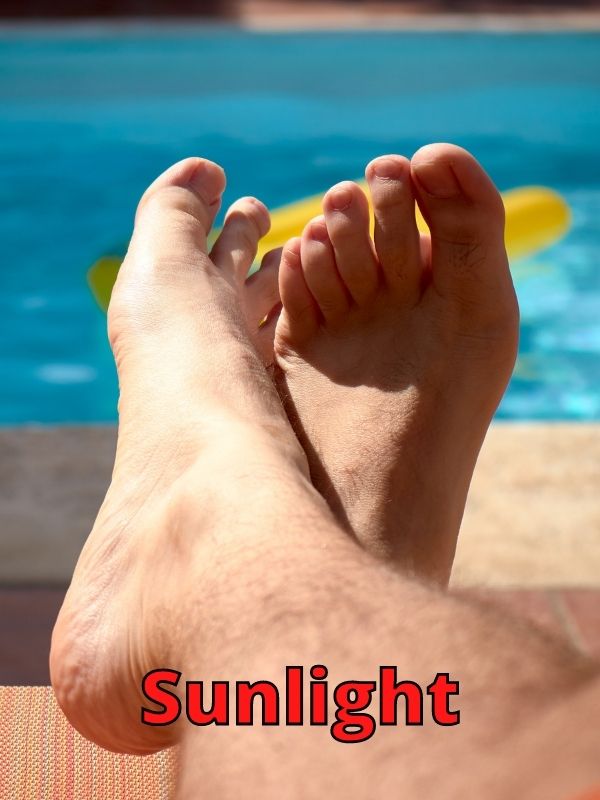
If you keep getting athlete’s foot or it doesn’t want to go away, consider using sunlight to help keep it away for good. When you expose fungus to ultraviolet light found in sunlight, it can “kill fungi.” (physicianoneurgentcare.com)
In addition, you can let your socks, towels, and shoes get exposed to the sunlight by hanging them outside. This ensures that if the athlete’s foot is still present on items after they are washed, the sun will help kill any remaining fungus.
So, sit back, relax, and put your feet up literally in the sun a little each day to help control and get rid of athlete’s foot. Just don’t overdo it because a sunburn may be even more harmful to you.
5. Hydrogen Peroxide
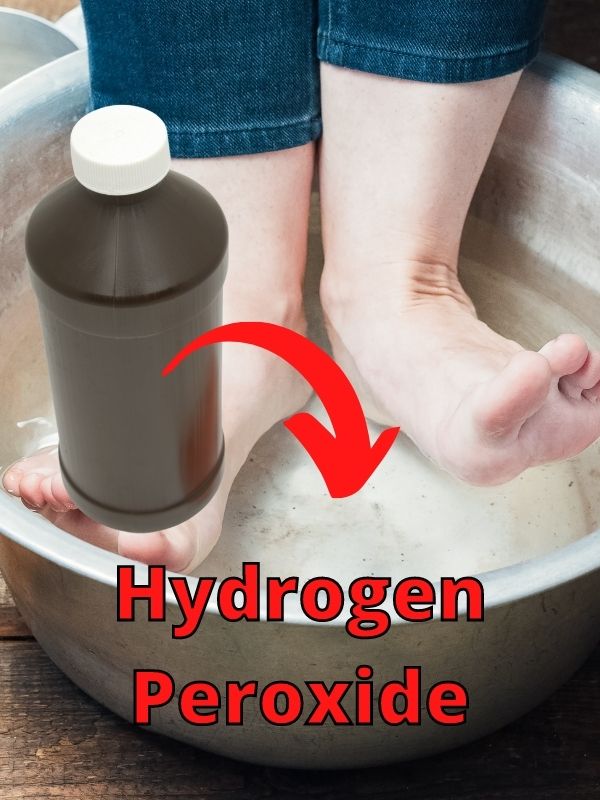
According to slcpodiatrist.com, you can use a bath of 1 gallon of water and a pint (16 oz.) to soak your feet for about 30 minutes. Be aware that your feet may hurt if you have any open wounds on your feet.
I would test it out for a minute first to see how your skin reacts to the solution. If everything seemed fine, I would go for longer and continue to check my feet every so often. Hydrogen peroxide is a powerful cleaning agent, so use it with caution.
It can kill the bacteria and fungus on the top layer of your skin.
Your Foot’s Environment
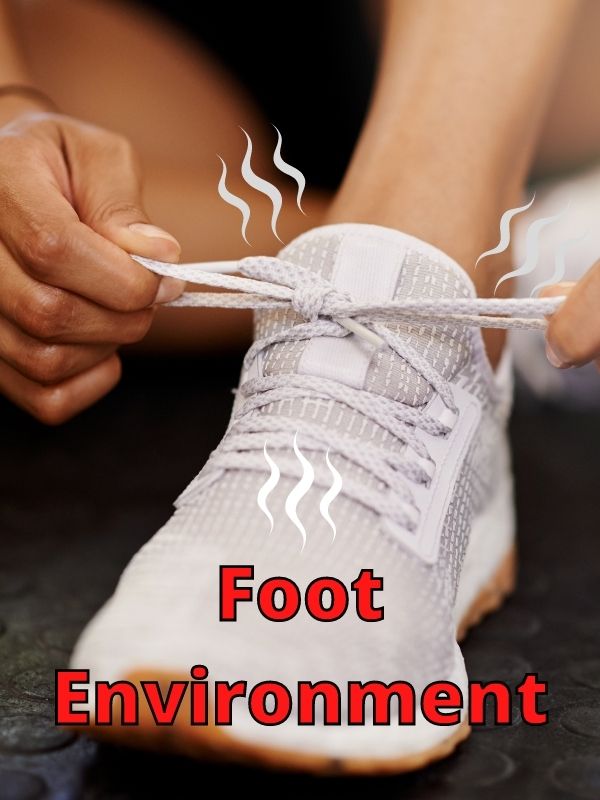
Everyone is a bit different. Each person’s feet sweat a bit differently. Some people need to watch out for too much moisture build-up. This can cause problems for our feet, ranging from smelly feet to athlete’s foot. Keeping your feet dry and cool is one way to help them prevent foot problems.
During exercise, we sweat and our feet need to be well-ventilated. Wearing breathable athletics socks and mesh shoes can help your feet stay drier and cooler. If you’re hiking you may be wearing hiking boots and two layers of socks. Make sure the socks can wick away moisture from your skin.
Warmth and moisture can help the fungus grow. You can avoid infection by keeping your feet and shoes dry and cool. This isn’t always possible but you can take steps to avoid situations that cause too much moisture from building up around your foot.
Shoes and Athlete’s Foot
The shoes we wear can make a difference when it comes to athlete’s foot. Breathable shoes help your feet breathe, making it more difficult for fungus to take hold. Check the shoes that you have to see if they are suitable for preventing and reducing levels of athlete’s foot.
Change your shoes if needed to allow your feet to breathe. If they have plenty of mesh for ventilation, this is helpful. After you get home, take your shoes off right away and take your socks off if needed.
Let your shoes thoroughly dry before using them again. Corn starch can be used as a powder to help with foot moisture before you put on your shoes, and baking soda can be used to help kill bacteria and fungus that may be lingering in your shoe after you take it off.
See this article for other ways to clean inside your shoes.
Socks and Athlete’s Foot
Socks that wick away moisture and are mesh-like in some areas can help your feet to breathe. There are many kinds of socks that help with moisture control. Look for athletic socks that claim to have moisture control. Running socks, thin wool and thin bamboo socks might be good.
Only use your socks once and put them in the laundry basket to wash. If needed, change your socks a couple of times a day if your feet get sweaty. This may reduce the amount of moisture around your foot if you tend to sweat even while you’re sitting.
After the gym or a workout, take off your socks, let your feet dry, and replace your socks with need ones if needed.
Reduce Infection Time and Spread
People in your family might also get athlete’s foot if you have it. Take the time to clean your feet well and ask family members to wear flip-flops in the shower if you’re worried about it spreading to them.
Wash any items that may come in contact with your feet, such as your towel and socks, regularly, and try not to let others come into contact with them until they are washed and dried.
Athlete’s foot spreads fairly easily, so you can prevent reinfection prevent it from spreading to other areas of the body or other people by limiting contact with your foot, washing feet, and cleaning areas and items that may have been touching your feet.
This fungus likes warm and moist areas, so keep your bathroom ventilated and hang your socks and your towels to dry after use.
Protect yourself from reoccurrences of athlete’s foot by wearing flip-flops at the gym or the pool and using sandals or well-ventilated shoes. If you think your feet are getting warm or moist, change your socks and let your feet dry out.
Final Thoughts
I believe it’s possible to get rid of most athletes’ feet with time and patience. If you can keep up a healthy routine of self-treatment, you can reduce and eliminate the problems caused by the athlete’s foot and eventually get rid of it.
If you have athlete’s foot, remember not to ignore it too long or it can cause more problems. Once you notice signs of athlete’s foot you can start to do simple things to avoid moisture and treat it even before taking medicine. Then, you can get the medicine you need to stop it altogether.
Thanks for visiting Helpshoe.com

